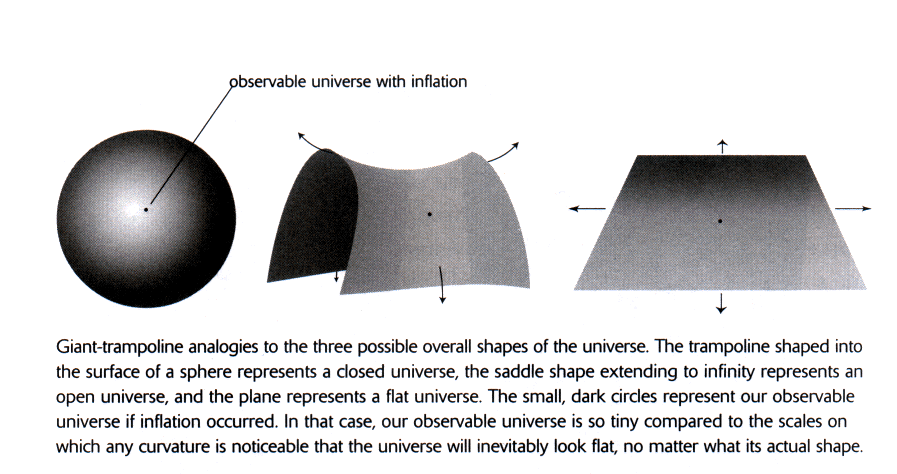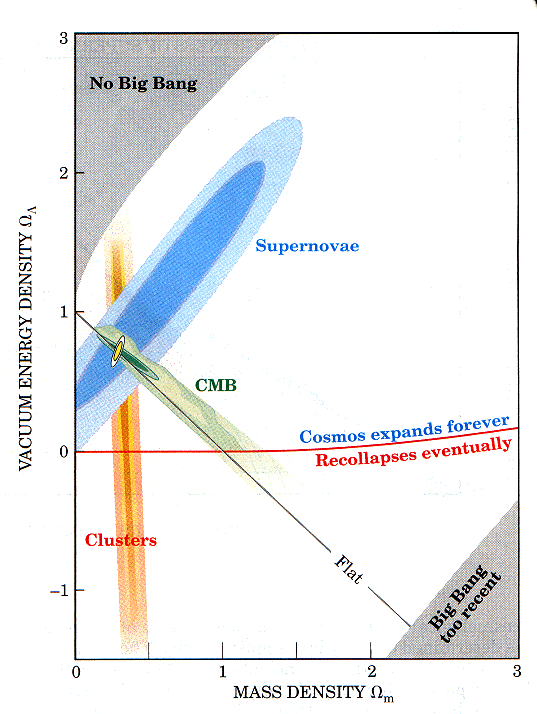the rate that galaxies are moving away from us / distance from usconverts red-shift to distance
can be used to estimate the time since the singularityfor a very simple explanation, see "On the Cosmic Horizon", J. Bennett, Mystery #3.
~65 kilometers per second / megaparsec (1 megaparsec = 3.26 million light years)
2. Wm
- The mass density of the universe
determines the fate of the universe (assuming no dark energy): the greater the mass density the greater the gravitational attraction
Wm > 1 : the expansion will eventually stop and the universe will collapse
Wm < 1 : the universe will continue to expand forever
Wm = 1 : the "critical" density, the dividing line between the two fates
also determines the shape of the universe (assuming no dark energy):"less than an ounce of matter spread through the volume the size of Jupiter."K. Croswell, Magnificent Universe, pg 175.
Wm > 1 : a "closed" universe, space-time curves back on itself - shape is analogous to the surface of a sphere
Wm < 1 : an "open" universe, space-time forms a saddle shape
Wm = 1 : a "flat" universe, space-time forms a shape analogous to a flat plane

significance for inflation theory:
"In fact, inflation makes only one known, directly testable prediction, which is the prediction that tied up our third loose end. The universe should be flat and have precisely the critical density."J. Bennett, "On the Cosmic Horizon", p 131.combining visible matter + "dark matter", Wm= ~ 0.3
3. WL
- the vacuum energy density (the "cosmological constant"
or ? )
based on recent observations of type I supernovae in distant galaxies that suggest that the more distant galaxies seem to be moving more slowly with expansion than nearby galaxies - implies that the expansion has accelerated with time for some portion of the recent past.
WL represents a force of repulsion and accelerates the expansion, the opposite of Wm
still highly controversial
significance for inflation theory:
"If the cosmological constant proves real, at least one group of scientists will be popping champagne corks: the theorists of inflation. ... because Einstein showed that mass and energy are equivalent, the energy embodied in the cosmological constant can also add to the total density in the universe."Current status:J. Bennett, "On the Cosmic Horizon", pg 149.
"Here at the dawn of the millennium, the data are not yet sufficient to say definitively whether the expansion is really accelerating and there really is a cosmological constant. The case should become clear within a few years, however, as additional observations allow us to improve our measurements of the Hubble constant both for the present and for the past."J. Bennett, "On the Cosmic Horizon", pg 148.
summary of current status
From Supernovae, Dark Energy, and the Accelerating Universe, S. Perlmutter, Physics Today, April 2003 p 59.
Inflationary expectation (flatness): Wm + WL = 1
Three independent sets of observations - high-redshift supernovae, galaxy cluster inventories, and the CMB converge near Wm = 0.3 and WL = 0.7
If true, then 97 % of "everything" in the universe is dark matter or dark energy!
